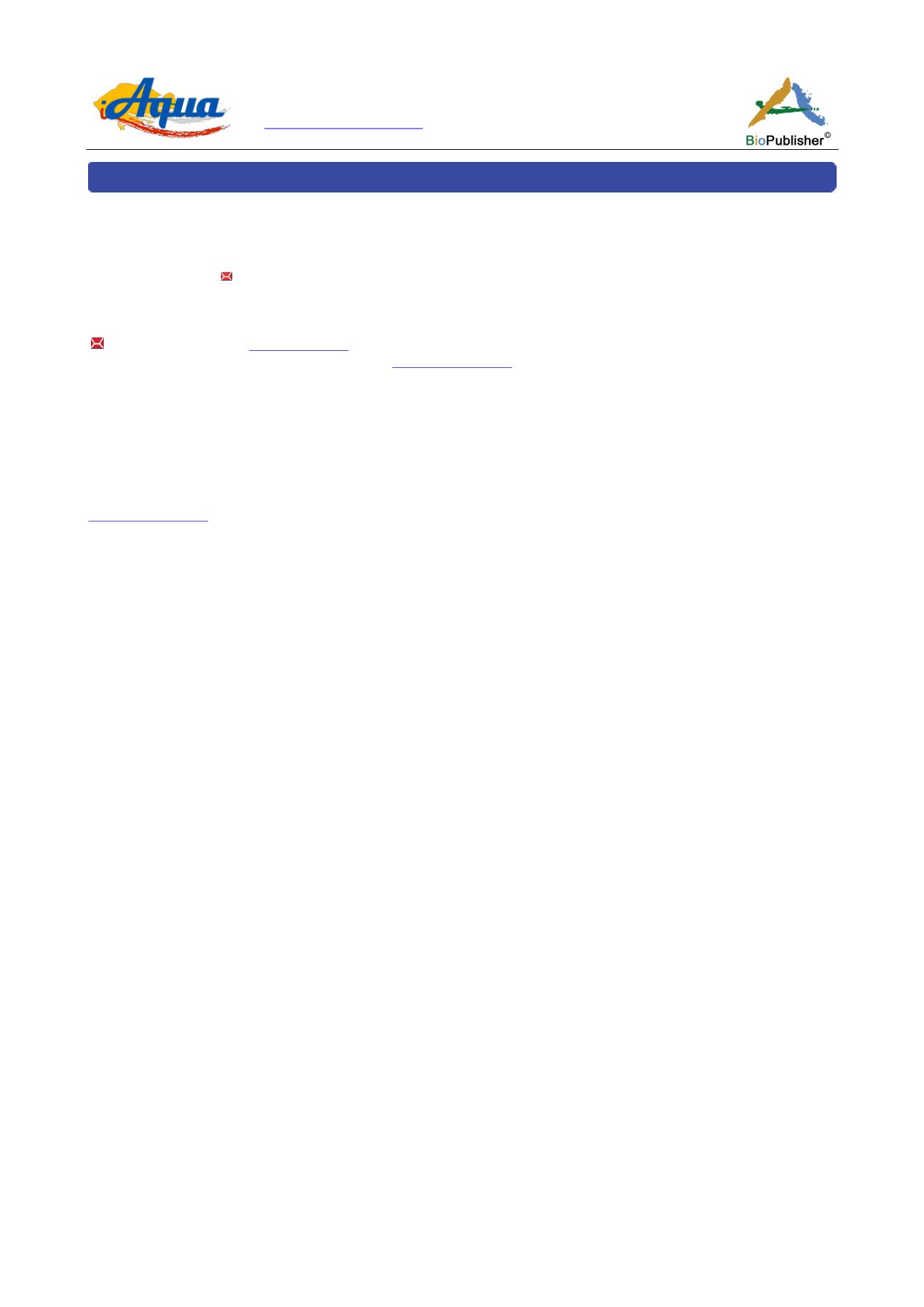
International Journal of Aquaculture, 2018, Vol.8, No.18, 137-144
137
Research Report Open Access
Effect of Stocking Density on the Survival and Growth of
Hoplobatrachus
occipitalis
(Günther, 1858) (Amphibia: Dicroglossidae) of Tadpoles Reared in
Ponds
from Benin
Théophile Godome
1, 2
, Ephrem Tossavi
1
, Arnauld Djissou
1
, Yaovi Zounon
1
, Nahoua Issa Ouattara
2
, Emile Didier Fiogbe
1
1 Laboratoire de Recherches sur les Zones Humides, Département de Zoologie, Faculté des Sciences et Techniques, Université d’Abomey-Calavi, BP: 526
Cotonou, Bénin
2 Laboratoire d’Hydrobiologie, UFR Biosciences, Université Félix Houphouet-Boigny, 22BP: 582 Abidjan 22, Côte d’Ivoire
Corresponding author Email
International Journal of Aquaculture, 2018, Vol.8, No.18 doi
Received: 14 May, 2018
Accepted: 28 Jun., 2018
Published: 27 Jul., 2018
Copyright © 2018
Godome et al., This is an open access article published under the terms of the Creative Commons Attribution License, which permits
unrestricted use, distribution, and reproduction in any medium, provided the original work is properly cited.
Preferred citation for this article
:
Godome T., Tossavi E., Djissou A., Zounon Y., Ouattara N.I., and Fiogbe E.D., 2018, Effect of stocking density on the survival and growth of
Hoplobatrachus
occipitalis
(Günther, 1858) (Amphibia: Dicroglossidae) of tadpoles reared in Ponds from Benin, International Journal of Aquaculture, 8(18): 137-144 (doi:
Abstract
The current study aims to evaluate the effect of density on the survival and growth of
Hoplobatrachus occipitalis
tadpoles
in circular plastic ponds (Diameter: 24 cm; volume: 60 L) for 24 days. Four stocking densities (5, 10, 15 and 20 tadpoles/L),
respectively represented by D
1
, D
2
, D
3
, and D
4
were tested on tadpoles (initial mean weight 0.283 ±0.031 g) in triplicate. Tadpoles
were daily fed at 6% of biomass every hour from 8 a.m to 6 p.m on Coppens fish feed. At the end of experiment, parameters such as
final biomass (9.386 ±0.240 to 23.750 ±0.601 g), specific growth rate (1.960 ±0.326 to 4.220 ±0.255%/d-1), daily weight gain
(0.022 ±0.021 to 0.735 ±0.026 g/d), survival rate (30.388 ±1.734 to 86.333 ±3.333%) and feed conversion rate (1.436 ±0.023 to
2.185 ±0.218) showed the lowest values in the highest stocking densities. The final biomass, specific growth rate, daily weight gain
and survival rate recorded in D
1
tadpoles were significantly higher (
p
˂0.05) compared to the other lots. Thus the optimal stocking
density is 5 tadpoles/L to ensure a good growth of
H. occipitalis
tadpoles in circular ponds. Indeed, this density has been chosen in
relation to the space required by tadpoles for good zootechnical performances.
Keywords
Hoplobatrachus occipitalis
; Intensive rearing; Tadpoles; Stocking density
Background
The increase in world-wide population by the later years requires an increase in natural resources such as water,
energy and food (Beddington, 2011). For that purpose, new rearing approaches that enable reduction of
environmental pollution and maximizing the synthesis of high quality biological protein were envisaged
(Munguia-Fragozo et al., 2015). Nevertheless, the rearing of
Hoplobatrachus occipitalis
is a trust able solution to
satisfy this demand. However, due to its complex life cycle, many rearing methods must be applied in each stage
of its life. In aquaculture, two factors determine the available biomass quantity: individual growth and the number
of individuals (Flores-Nava and Vera-Muñoz, 1999). These two factors are often inversely proportional as growth
is generally influenced by rearing density (Flores-Nava and Vera-Muñoz, 1999). Though there is an incomplete
understanding of why density reduces growth and provokes metamorphosis of small height tadpoles, the effect on
growth and development at different densities is actual and measurable (Wilbur and Collins, 1973).
In frog rearing, growth and metamorphosis time of tadpoles are affected by the stocking density (Wilbur, 1977;
Collins, 1979; Hota and Dash, 1981; Fontanello et al., 1988). Reservoirs’ volume and content (individual number)
is one of the noteworthy questions to be studied. Negative effects of growth of density on the frogs growth rate
and development were studied by many authors (Licht, 1967; Wilbur, 1977b; Smith-Gill and Berven, 1979; Travis,
1981; Semlitsch and Caldwell, 1982).
Besides that, several researches focused on the food diet (Alfredo, 1996; Mady-Goma, 2012), biology (Wells,
1977; Barbault, 1984; Heyer et al., 1994; Rödel, 2000; Morin, 2008; Tohé, 2009), ecology (Rödel, 2000; Wildlife
et al., 2007; Tohé, 2009) of
H. occipitalis
but dids relative to stocking density of this species remain narrow. The


